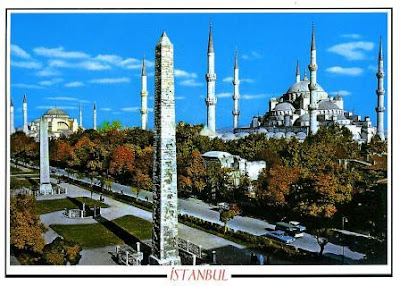Bled is a town on Lake Bled in the Upper Carniolan region of northwestern Slovenia. Bled is known for the glacial Lake Bled, which makes it a major tourist attraction. Perched on a rock overlooking the lake is the iconic Bled Castle and in the middle of the lake there's the only natural island of the country.
These beautiful cards were sent by Ivana, Leonardo and Sunny.
Foto © A. Kosmac
The Bled Lake came into existance when the Bohinj Glacier moved away. It is 2120 m long, up to 1380 m wide and it is of the tectonic origin. After the last Ice Age, the Bohinj Glacier deepend its natural tectonic hollow and gave it its present form. When the ice melted the basin was filled with water. The lake has no considerable affluents except some streams. - in: http://www.slovenia.info/en/jezero/Lake-Bled.htm?jezero=190&lng=2
Foto: Janez Skok
The lake is situated in a picturesque environment, surrounded by mountains and forests. The medieval-era Bled Castle stands above the lake on the north shore.
Foto: Marko Prezelj
Above the surface of Bled Lake rises the only real island in Slovenia. In a glacier hollow there is what remains of an Ice Age limestone moraine covered with trees.
According to a legend, the temple of the ancient Slavic goddess Živa, once stood in the place of the present Baroque church. The temple disappeared during battles between the followers of the pagan religion and Christians, who destroyed the altar and built a church.
According to written sources, the first masonry church on the island, a three-nave Romanesque basilica, was consecrated by the Aquilean patriarch Pellegrino in 1142.
In the 15th century, it was rebuilt in the Gothic style.
In 1509 it was damaged by an earthquake to such an extent that it required thorough renovation, and this was carried out in the Baroque style. Only the frescoes in the presbytery and a wooden statue of the Virgin Mary, which probably adorned the main altar, were preserved from the previous Gothic church.
The present form of the church dates from the 17th century when it was renovated after another earthquake.
The bell tower, which was built in the 15th century, has been renovated several times due to damage by two earthquakes, and in 1688 it was struck by lightning. The present tower is 54 m high.
Of special interest is the ""wishing bell"" from 1534 in the upper roof beam above the church nave, by F. Patavina from Padova. According to the legend, a young widow Poliksena once lived at the Bled Castle, who had a bell casted for the chapel on the island in memory of her husband. During the transport of the bell, a terrible storm struck the boat and sank it together with the crew and the bell, which to this day is said to ring from the depths of the lake. After the widow died, the Pope consecrated a new bell and sent it to the Bled Island. It is said that whoever rings this bell and thereby gives honour to Virgin Mary gets his wish come true. - in: http://www.bled.si/en/what-to-see/cultural-sights/churches/the-church-on-the-island
Foto: Dorinka Mladenovic
The island church with its bell invites all visitors. The best way to get to the island is by the traditional Bled special boat called Pletna.
To get to the island church there's a Baroque stairway from 1655 with 99 stone steps leading up to the building. The church is frequently visited and weddings are held there regularly. Traditionally it is considered good luck for the groom to carry his bride up the steps on the day of their wedding before ringing the bell and making a wish inside the church.
Foto: Dorinka Mladenovic
Bled Castle is a medieval castle built on a precipice above the city of Bled in Slovenia, overlooking Lake Bled. According to written sources, it is the oldest Slovenian castle and is currently one of the most visited tourist attractions in Slovenia.
The castle was first mentioned in a 22 May 1011 deed of donation issued by Emperor Henry II in favour of the Bishops of Brixen. Then located in the March of Carniola, it passed to the Austrian House of Habsburg in 1278.
The oldest part of the castle is the Romanesque tower. In the Middle Ages more towers were built and the fortifications were improved. Other buildings were constructed in the Renaissance style.
The buildings are arranged around two courtyards, which are connected with a staircase. There is a chapel on the upper courtyard, which was built in the 16th century, and renovated around 1700, when it was also painted with illusionist frescoes. The castle also has a drawbridge over a moat. - in: wikipedia




































